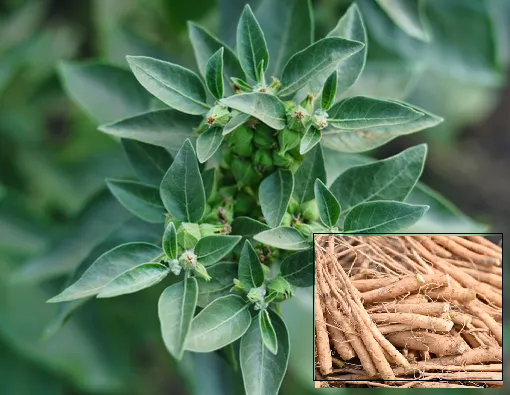Latin Name: Withania somnifera
Plant Origin and Preferred Growing Habitat:
Ashwagandha, also known as Indian ginseng or winter cherry, is native to India, the Middle East, and parts of Africa. This hardy plant thrives in dry, arid climates and prefers well-drained sandy or loamy soil. It can tolerate extreme temperatures, making it well-suited to semi-arid regions.
General Appearance:
Ashwagandha is a small, woody shrub that grows up to 1.5 meters (5 feet) tall. It features:
- Green, elliptical leaves.
- Bell-shaped yellow-green flowers.
- Orange-red berries that encase the seeds.
The plant’s roots are thick and tuberous, which are the primary part used in traditional medicine.

Benefits as a Herb:
Ashwagandha is revered in Ayurveda for its adaptogenic properties, which help the body resist stress and restore balance. Key benefits include:
- Stress and Anxiety Relief: Reduces cortisol levels and calms the nervous system.
- Energy and Stamina: Improves physical performance and combats fatigue.
- Immune System Support: Enhances immunity and overall vitality.
- Cognitive Function: Boosts memory, focus, and mental clarity.
- Hormonal Balance: Supports thyroid and adrenal function.
- Anti-Inflammatory Effects: Reduces inflammation and supports joint health.
- Sexual Health: Acts as a natural aphrodisiac and improves reproductive health.
How to Process for Consumption as Medicine:
Ashwagandha is versatile and can be consumed in various forms:
- Powder Form:
- Dry the roots thoroughly and grind them into a fine powder.
- Dosage: Mix 1 teaspoon of powder with warm milk or water, adding honey if desired. Consume daily.
- Tea:
- Boil 1–2 teaspoons of dried root pieces in 2 cups of water for 10–15 minutes.
- Strain and drink.
- Capsules or Tablets:
- Purchase standardized ashwagandha supplements for convenience.
- Follow dosage instructions on the product label.
- Infused Oil:
- Roots can be infused into oils for external applications to soothe sore muscles and joints.
- Tonic:
- Combine ashwagandha powder with ghee, honey, and milk for a nourishing tonic.
Caution:
- Avoid use during pregnancy without medical supervision, as it may stimulate uterine contractions.
- Consult a healthcare provider before use if you have a medical condition or are taking medications.
Ashwagandha remains a cornerstone of holistic health practices, promoting longevity and balance in both body and mind.

Leave a Reply